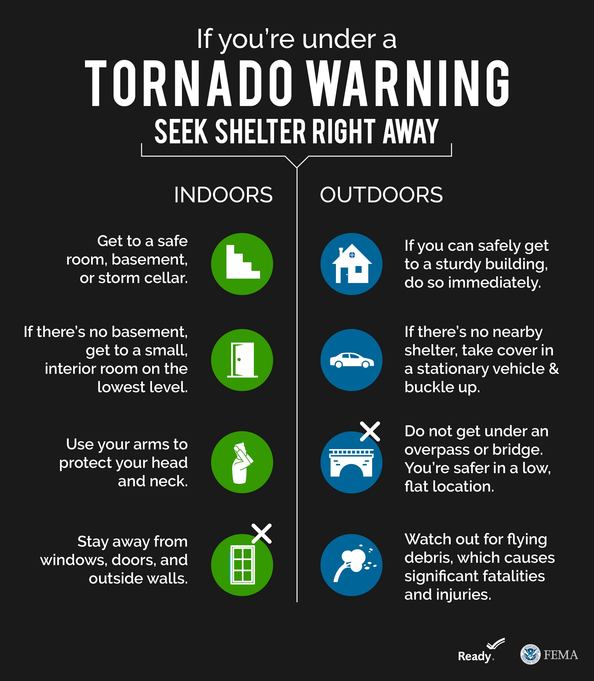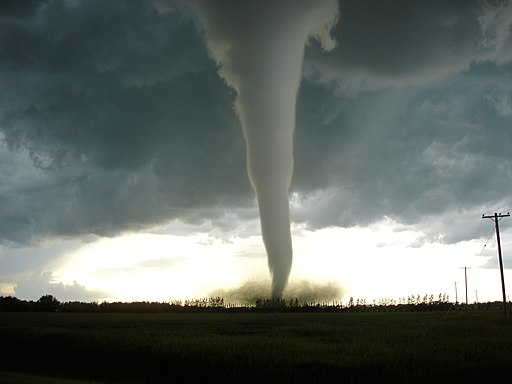Tornadoes are nature’s most violent storms. Spawned from powerful thunderstorms, tornadoes can cause fatalities and devastate a neighborhood in seconds. A tornado appears as a rotating, funnel-shaped cloud that extends from a thunderstorm to the ground with whirling winds that can reach 300 miles per hour. Damage paths can be in excess of one mile wide and 50 miles long. Every state is at some risk from this hazard.
Some tornadoes are clearly visible, while rain or nearby low-hanging clouds obscure others. Occasionally, tornadoes develop so rapidly that little, if any, advance warning is possible. Before a tornado hits, the wind may die down and the air may become very still. A cloud of debris can mark the location of a tornado even if a funnel is not visible. Tornadoes generally occur near the trailing edge of a thunderstorm. It is not uncommon to see clear, sunlit skies behind a tornado.
Before a Tornado
- To begin preparing, you should build an emergency kit and make a family communications plan.
- Listen to NOAA Weather Radio or to commercial radio or television newscasts for the latest information. In any emergency, always listen to the instructions given by local emergency management officials.
- Be alert to changing weather conditions. Look for approaching storms.
- Look for the following danger signs:
- Dark, often greenish sky
- Large hail
- A large, dark, low-lying cloud (particularly if rotating)
- Loud roar, similar to a freight train.
- If you see approaching storms or any of the danger signs, be prepared to take shelter immediately.
Tornado Facts
Quick facts you should know about tornadoes:
- They may strike quickly, with little or no warning.
- They may appear nearly transparent until dust and debris are picked up or a cloud forms in the funnel.
- The average tornado moves Southwest to Northeast, but tornadoes have been known to move in any direction.
- The average forward speed of a tornado is 30 mph, but may vary from stationary to 70 mph.
- Tornadoes can accompany tropical storms and hurricanes as they move onto land.
- Waterspouts are tornadoes that form over water.
- Tornadoes are most frequently reported east of the Rocky Mountains during spring and summer months.
- Peak tornado season in the southern states is March through May; in the northern states, it is late spring through early summer.
- Tornadoes are most likely to occur between 3 pm and 9 pm, but can occur at any time.
When the Storm Comes
Know the Terms
Familiarize yourself with these terms to help identify a tornado hazard:
Tornado Watch - Tornadoes are possible. Remain alert for approaching storms. Watch the sky and stay tuned to NOAA Weather Radio, commercial radio or television for information.
Tornado Warning - A tornado has been sighted or indicated by weather radar. Take shelter immediately.

During a Tornado
If you are under a tornado warning, seek shelter immediately! Most injuries associated with high winds are from flying debris, so remember to protect your head.
If you are in:
| Then: | |
|---|---|
| A structure (e.g. residence, small building, school, nursing home, hospital, factory, shopping center, high-rise building) |
|
| A manufactured home or office |
|
| The outside with no shelter |
If you are not in a sturdy building, there is no single research-based recommendation for what last-resort action to take because many factors can affect your decision. Possible actions include:
In all situations:
|
After a Tornado
- Listen to local officials for updates and instructions.
- Check-in with family and friends by texting or using social media.
- Watch out for debris and downed power lines.
- If you are trapped, do not move about or kick up dust. Tap on a pipe or wall or use a whistle, if you have one, so that rescuers can locate you.
- Stay out of damaged buildings and homes until local authorities indicate it is safe.
- Photograph the damage to your property in order to assist in filing an insurance claim.
- Do what you can to prevent further damage to your property, (e.g., putting a tarp on a damaged roof), as insurance may not cover additional damage that occurs after the storm.
- If your home is without power, use flashlights or battery-powered lanterns rather than candles to prevent accidental fires.
Build a Safe Room
Extreme windstorms in many parts of the country pose a serious threat to buildings and their occupants. Your residence may be built "to code" but that does not mean it can withstand winds from extreme events such as tornadoes and major hurricanes. The purpose of a safe room or a wind shelter is to provide a space where you and your family can seek refuge that provides a high level of protection. You can build a safe room in one of several places in your home.
- Your basement
- Atop a concrete slab-on-grade foundation or garage floor.
- An interior room on the first floor.
Safe rooms built below ground level provide the greatest protection, but a safe room built in a first-floor interior room also can provide the necessary protection. Below-ground safe rooms must be designed to avoid accumulating water during the heavy rains that often accompany severe windstorms.
To protect its occupants, a safe room must be built to withstand high winds and flying debris, even if the rest of the residence is severely damaged or destroyed. Consider the following when building a safe room:
- The safe room must be adequately anchored to resist overturning and uplift.
- The walls, ceiling and door of the shelter must withstand wind pressure and resist penetration by windborne objects and falling debris.
- The connections between all parts of the safe room must be strong enough to resist the wind.
- Sections of either interior or exterior residence walls that are used as walls of the safe room must be separated from the structure of the residence so that damage to the residence will not cause damage to the safe room.
Additional information about Safe Rooms available from FEMA:
- Taking Shelter from the Storm: Building a Safe Room Inside Your House. FEMA L-233. Brochure providing details about obtaining information about how to build a wind-safe room to withstand tornado, hurricane and other high winds.
- Taking Shelter from the Storm: Building a Safe Room Inside Your House. FEMA L-320. Manual with detailed information about how to build a wind-safe room to withstand tornado, hurricane and other high winds.
Resources
If you require more information about any of these topics, the following resources may be helpful.
- Tornado Protection - Selecting Refuge Areas in Buildings. FEMA 431. Intended primarily to help building administrators, architects and engineers select the best available refuge areas in existing schools.
- How to Guides to Protect Your Property or Business from High Winds.
Related Websites
Find additional information on how to plan and prepare for a tornado and learn about available resources by visiting the following websites:
Listen to Local Officials
Learn about the emergency plans that have been established in your area by your state and local government. In any emergency, always listen to the instructions given by local emergency management officials.

 From Ready.gov
From Ready.gov




